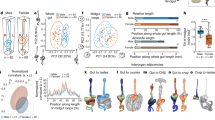Abstract
ASYNCHRONOUS (myogenic) insect flight muscles have evolved independently at least seven times1. Although such muscles do not necessarily contract at particularly high frequencies, potentially they allow far greater wing stroke rates than synchronous muscle which, because of the delays involved in muscle activation, has been believed to be incapable of operating at frequencies above ∼ 100 Hz (ref. 2), unless power output is small and much of the muscle volume occupied by sarcoplasmic reticulum3. Asynchronous muscle has so far always been shown to be of the ‘fibrillar’ histological type, and this correspondence has been assumed to be invariable1. Predictably, very small insects, for which a high stroke frequency is believed to be essential2, almost always have fibrillar flight muscle. However, a few groups, notably the hemipterous family Aleyrodidae (whitefly), have muscle of the ‘close-packed’ type, hitherto supposed to operate only synchronously1. We have measured cinematographically the wing-beat frequencies of the whitefly Trialeurodes vaporariorum (Westwood), and report here that they are well above the usually assumed limit for synchronous functioning. Either this limit, or the assumption that all asynchronous muscle is of fibrillar type, must therefore be incorrect.
This is a preview of subscription content, access via your institution
Access options
Subscribe to this journal
Receive 51 print issues and online access
$199.00 per year
only $3.90 per issue
Buy this article
- Purchase on Springer Link
- Instant access to full article PDF
Prices may be subject to local taxes which are calculated during checkout
Similar content being viewed by others
References
Cullen, M. J. J. Ent. A 49, 17–41 (1974).
Pringle, J. W. S. Symp. R. ent. Soc. Lond. 7, 3–15 (1976).
Josephson, R. K. J. exp. Biol. 59, 781–801 (1973).
Greenewalt, C. H. Smithson. misc. Collns 144, 1–46 (1962).
Weis-Fogh, T. in Scale Effects in Animal Locomotion, 405–420 (Academic, New York, 1977).
Weis-Fogh, T. J. exp. Biol. 56, 79–104 (1972).
Weis-Fogh, T. J. exp. Biol. 59, 169–230 (1973).
Ellington, C. in Swimming and Flying in Nature, Vol. 2, 783–796 (Plenum, New York, 1974).
Author information
Authors and Affiliations
Rights and permissions
About this article
Cite this article
WOOTTON, R., NEWMAN, D. Whitefly have the highest contraction frequencies yet recorded in non-fibrillar flight muscles. Nature 280, 402–403 (1979). https://doi.org/10.1038/280402a0
Received:
Accepted:
Published:
Issue Date:
DOI: https://doi.org/10.1038/280402a0
This article is cited by
Comments
By submitting a comment you agree to abide by our Terms and Community Guidelines. If you find something abusive or that does not comply with our terms or guidelines please flag it as inappropriate.



